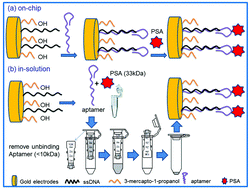A novel immobilization strategy for electrochemical detection of cancer biomarkers: DNA-directed immobilization of aptamer sensors for sensitive detection of prostate specific antigens†
Abstract
We report on a novel strategy for DNA aptamer immobilization to develop sensitive electrochemical detection of a protein biomarker, with prostate specific antigen (PSA) as a case biomarker. Thiolated single-stranded DNA (ssDNA) was co-immobilized with 3-mercapto-1-propanol on gold electrodes, and used as a scaffold for DNA aptamer attachment through hybridization of the aptamer overhang (so-called “DNA-directed immobilization aptamer sensors”, DDIAS). In the approach, the complementary DNA aptamer against PSA was assembled by the probe ssDNA onto the electrode to detect PSA; or the probe ssDNA directly hybridized with a complementary DNA aptamer/PSA complex following their pre-incubation in solution, so-called ‘on-chip’ and ‘in-solution’ methods, respectively. A double stranded DNA intercalator with a ferrocenyl (Fc) redox marker was synthesized to evaluate the feasibility of the strategy. The results demonstrate that the ‘in-solution’ method offers a favourable medium (in a homogeneous solution) for the binding between the aptamer and PSA, which shows to be more efficient than the ‘on-chip’ approach. DDIAS shows promising analytical performance under optimized conditions, with a limit of detection in the range of fM and low non-specific adsorption.


 Please wait while we load your content...
Please wait while we load your content...